Comprehensive Report: Teaching, Learning, and Assessment in Education
VerifiedAdded on 2021/01/02
|15
|4299
|495
Report
AI Summary
This report provides a comprehensive analysis of teaching, learning, and assessment within an educational context. It begins by emphasizing the importance of identifying and meeting individual learner needs through initial and diagnostic assessments. The report then explores the significance of promoting appropriate behavior, respect, equality, and diversity within the learning environment. It delves into the purpose and types of assessment, including formative and summative methods, and analyzes their effectiveness in meeting individual learner needs. Furthermore, the report examines the demonstration of minimum core elements in inclusive teaching and learning, the roles and responsibilities of educators, and relevant legislation and codes of practice. It also covers the development of schemes of work and teaching plans that cater to individual learner goals, as well as opportunities for learner feedback. The report concludes with a review of the effectiveness of planning, delivery, and assessment, and identifies areas for improvement in inclusive teaching practices.
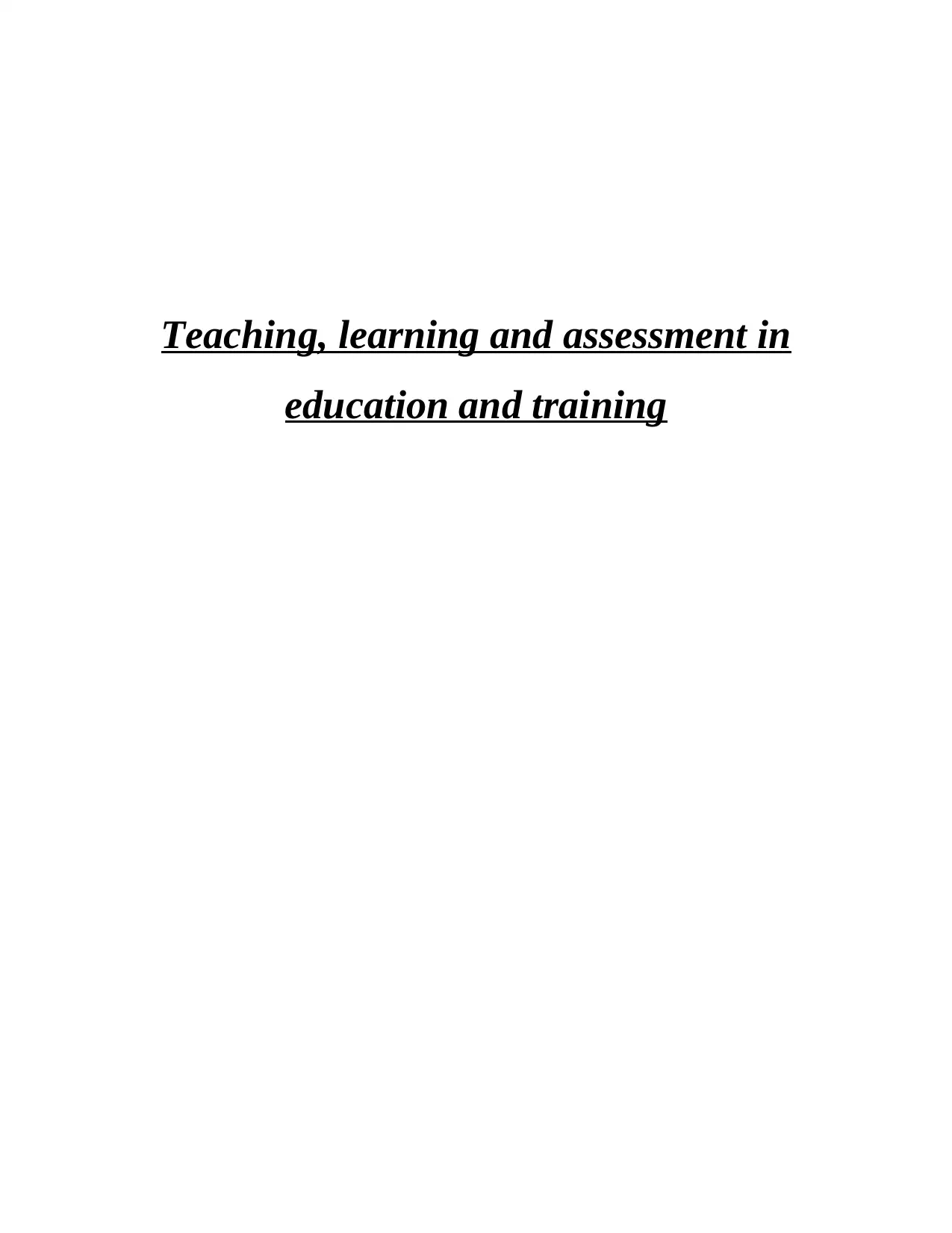
Teaching, learning and assessment in
education and training
education and training
Paraphrase This Document
Need a fresh take? Get an instant paraphrase of this document with our AI Paraphraser
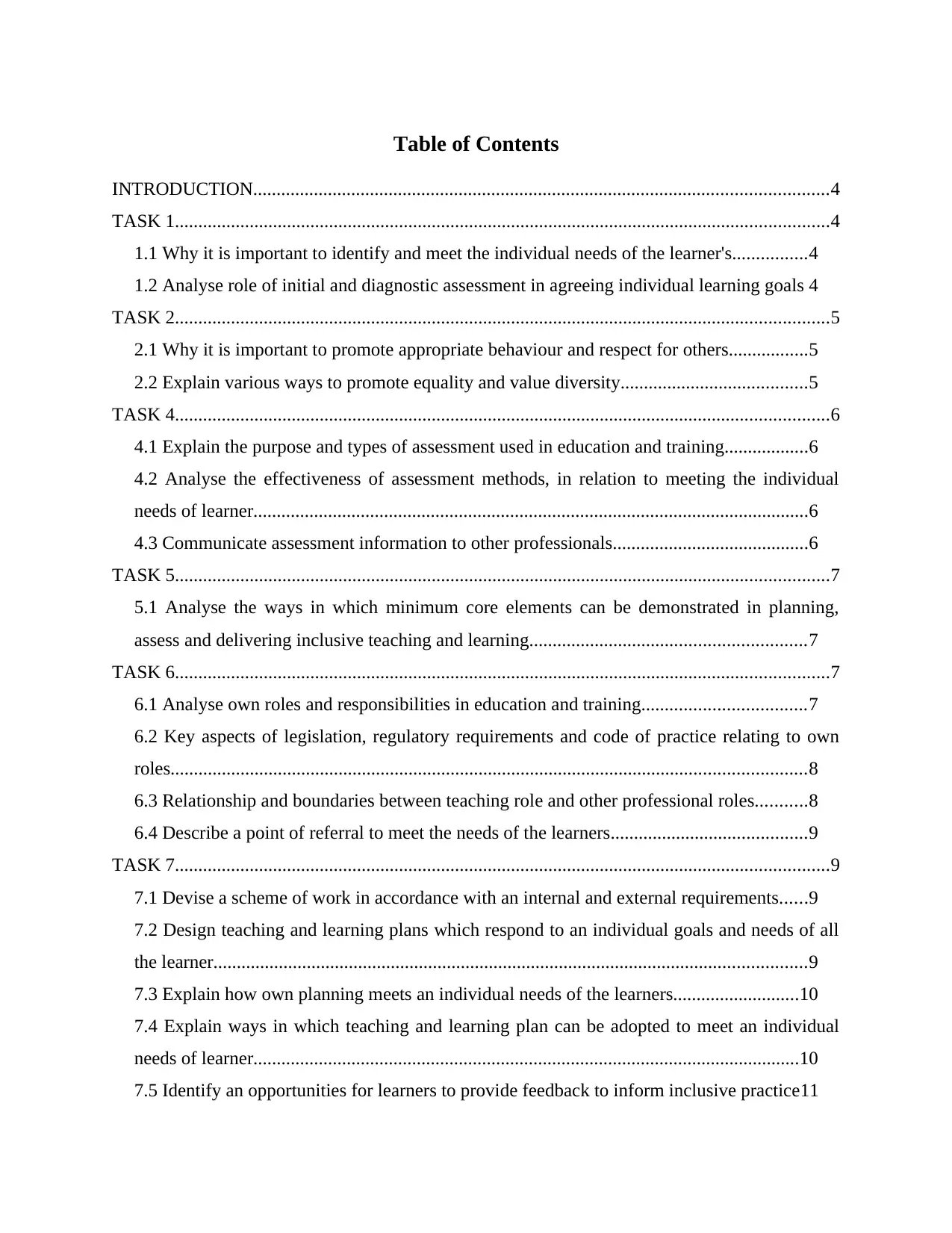
Table of Contents
INTRODUCTION...........................................................................................................................4
TASK 1............................................................................................................................................4
1.1 Why it is important to identify and meet the individual needs of the learner's................4
1.2 Analyse role of initial and diagnostic assessment in agreeing individual learning goals 4
TASK 2............................................................................................................................................5
2.1 Why it is important to promote appropriate behaviour and respect for others.................5
2.2 Explain various ways to promote equality and value diversity........................................5
TASK 4............................................................................................................................................6
4.1 Explain the purpose and types of assessment used in education and training..................6
4.2 Analyse the effectiveness of assessment methods, in relation to meeting the individual
needs of learner.......................................................................................................................6
4.3 Communicate assessment information to other professionals..........................................6
TASK 5............................................................................................................................................7
5.1 Analyse the ways in which minimum core elements can be demonstrated in planning,
assess and delivering inclusive teaching and learning...........................................................7
TASK 6............................................................................................................................................7
6.1 Analyse own roles and responsibilities in education and training...................................7
6.2 Key aspects of legislation, regulatory requirements and code of practice relating to own
roles........................................................................................................................................8
6.3 Relationship and boundaries between teaching role and other professional roles...........8
6.4 Describe a point of referral to meet the needs of the learners..........................................9
TASK 7............................................................................................................................................9
7.1 Devise a scheme of work in accordance with an internal and external requirements......9
7.2 Design teaching and learning plans which respond to an individual goals and needs of all
the learner...............................................................................................................................9
7.3 Explain how own planning meets an individual needs of the learners...........................10
7.4 Explain ways in which teaching and learning plan can be adopted to meet an individual
needs of learner.....................................................................................................................10
7.5 Identify an opportunities for learners to provide feedback to inform inclusive practice11
INTRODUCTION...........................................................................................................................4
TASK 1............................................................................................................................................4
1.1 Why it is important to identify and meet the individual needs of the learner's................4
1.2 Analyse role of initial and diagnostic assessment in agreeing individual learning goals 4
TASK 2............................................................................................................................................5
2.1 Why it is important to promote appropriate behaviour and respect for others.................5
2.2 Explain various ways to promote equality and value diversity........................................5
TASK 4............................................................................................................................................6
4.1 Explain the purpose and types of assessment used in education and training..................6
4.2 Analyse the effectiveness of assessment methods, in relation to meeting the individual
needs of learner.......................................................................................................................6
4.3 Communicate assessment information to other professionals..........................................6
TASK 5............................................................................................................................................7
5.1 Analyse the ways in which minimum core elements can be demonstrated in planning,
assess and delivering inclusive teaching and learning...........................................................7
TASK 6............................................................................................................................................7
6.1 Analyse own roles and responsibilities in education and training...................................7
6.2 Key aspects of legislation, regulatory requirements and code of practice relating to own
roles........................................................................................................................................8
6.3 Relationship and boundaries between teaching role and other professional roles...........8
6.4 Describe a point of referral to meet the needs of the learners..........................................9
TASK 7............................................................................................................................................9
7.1 Devise a scheme of work in accordance with an internal and external requirements......9
7.2 Design teaching and learning plans which respond to an individual goals and needs of all
the learner...............................................................................................................................9
7.3 Explain how own planning meets an individual needs of the learners...........................10
7.4 Explain ways in which teaching and learning plan can be adopted to meet an individual
needs of learner.....................................................................................................................10
7.5 Identify an opportunities for learners to provide feedback to inform inclusive practice11
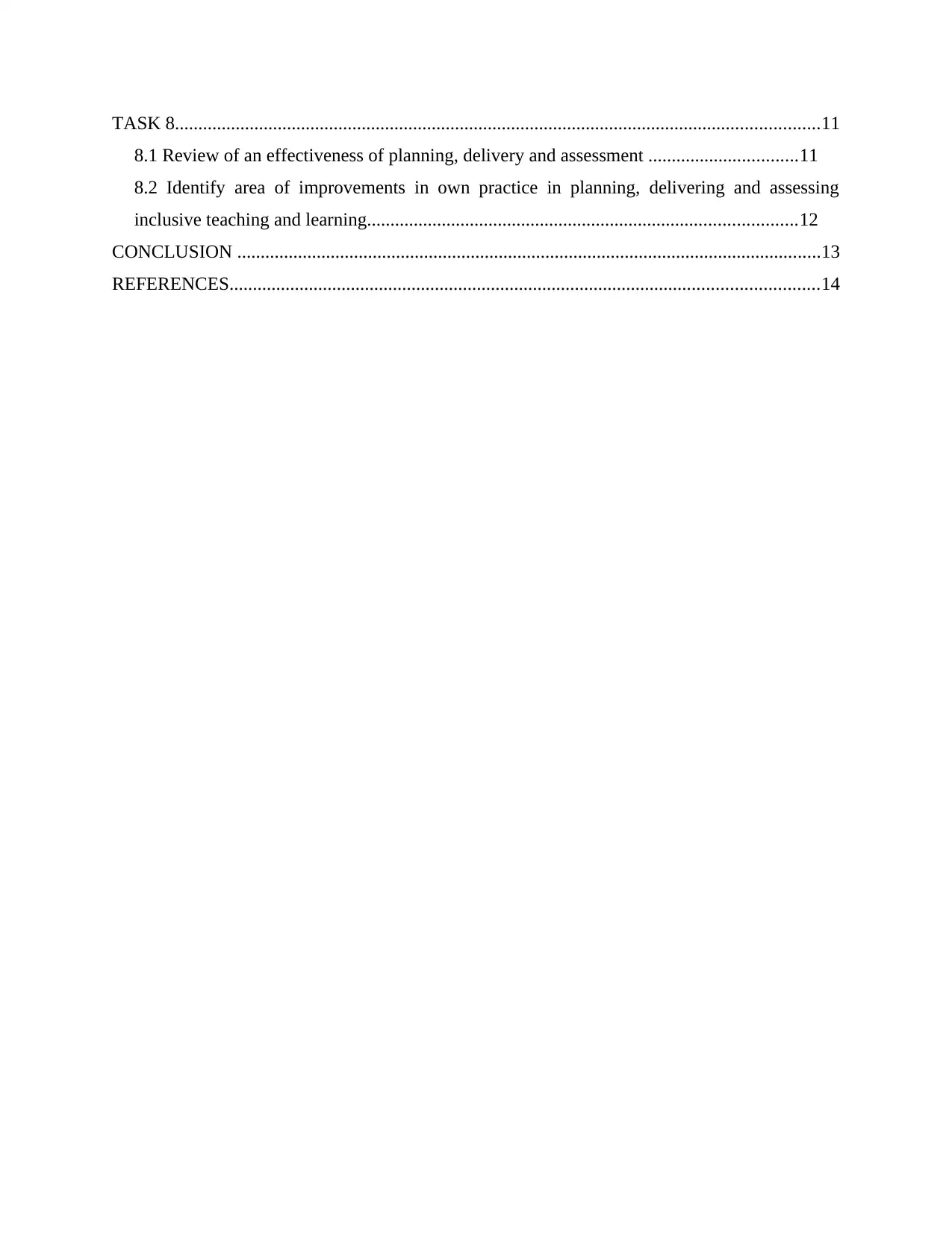
TASK 8..........................................................................................................................................11
8.1 Review of an effectiveness of planning, delivery and assessment ................................11
8.2 Identify area of improvements in own practice in planning, delivering and assessing
inclusive teaching and learning............................................................................................12
CONCLUSION .............................................................................................................................13
REFERENCES..............................................................................................................................14
8.1 Review of an effectiveness of planning, delivery and assessment ................................11
8.2 Identify area of improvements in own practice in planning, delivering and assessing
inclusive teaching and learning............................................................................................12
CONCLUSION .............................................................................................................................13
REFERENCES..............................................................................................................................14
⊘ This is a preview!⊘
Do you want full access?
Subscribe today to unlock all pages.

Trusted by 1+ million students worldwide
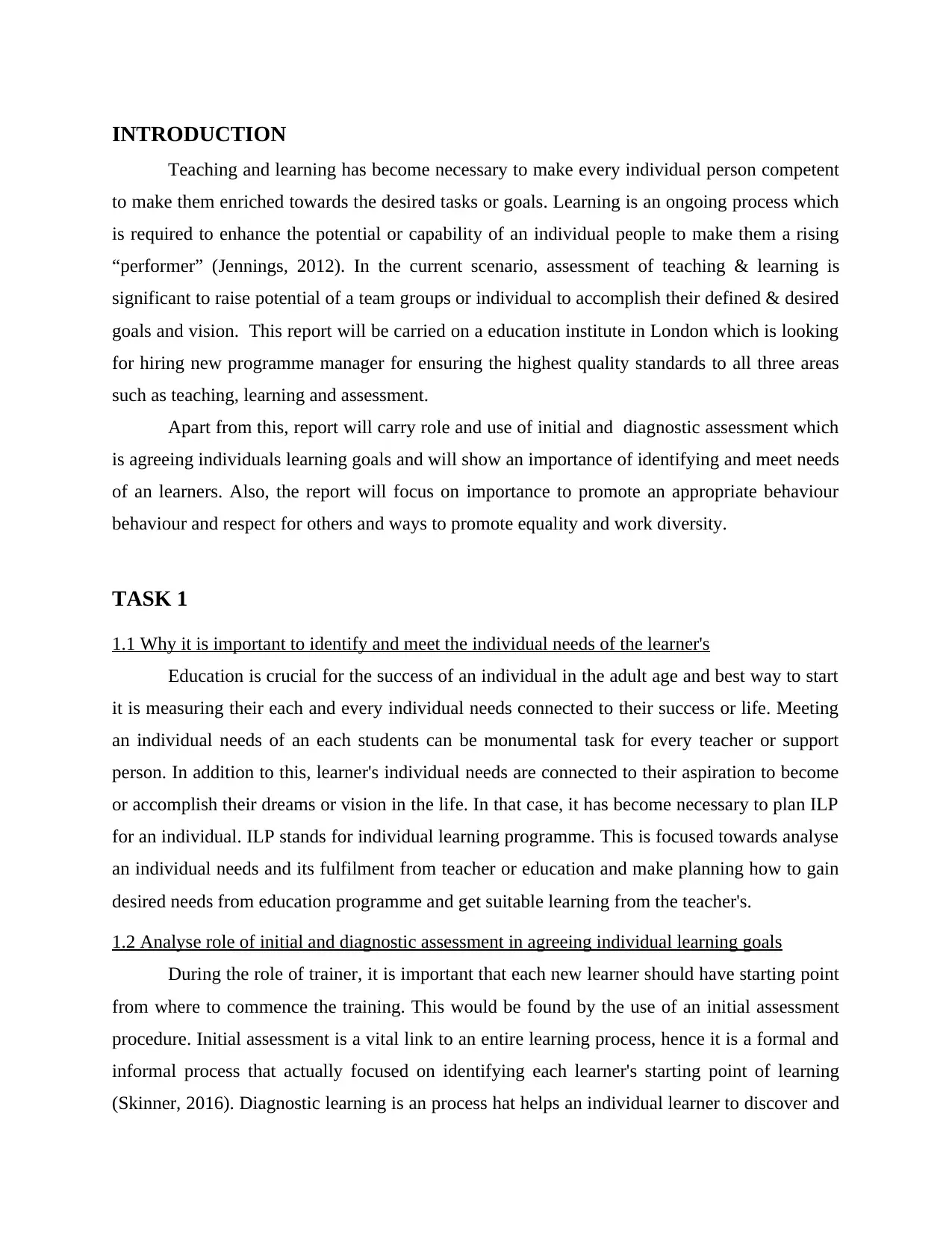
INTRODUCTION
Teaching and learning has become necessary to make every individual person competent
to make them enriched towards the desired tasks or goals. Learning is an ongoing process which
is required to enhance the potential or capability of an individual people to make them a rising
“performer” (Jennings, 2012). In the current scenario, assessment of teaching & learning is
significant to raise potential of a team groups or individual to accomplish their defined & desired
goals and vision. This report will be carried on a education institute in London which is looking
for hiring new programme manager for ensuring the highest quality standards to all three areas
such as teaching, learning and assessment.
Apart from this, report will carry role and use of initial and diagnostic assessment which
is agreeing individuals learning goals and will show an importance of identifying and meet needs
of an learners. Also, the report will focus on importance to promote an appropriate behaviour
behaviour and respect for others and ways to promote equality and work diversity.
TASK 1
1.1 Why it is important to identify and meet the individual needs of the learner's
Education is crucial for the success of an individual in the adult age and best way to start
it is measuring their each and every individual needs connected to their success or life. Meeting
an individual needs of an each students can be monumental task for every teacher or support
person. In addition to this, learner's individual needs are connected to their aspiration to become
or accomplish their dreams or vision in the life. In that case, it has become necessary to plan ILP
for an individual. ILP stands for individual learning programme. This is focused towards analyse
an individual needs and its fulfilment from teacher or education and make planning how to gain
desired needs from education programme and get suitable learning from the teacher's.
1.2 Analyse role of initial and diagnostic assessment in agreeing individual learning goals
During the role of trainer, it is important that each new learner should have starting point
from where to commence the training. This would be found by the use of an initial assessment
procedure. Initial assessment is a vital link to an entire learning process, hence it is a formal and
informal process that actually focused on identifying each learner's starting point of learning
(Skinner, 2016). Diagnostic learning is an process hat helps an individual learner to discover and
Teaching and learning has become necessary to make every individual person competent
to make them enriched towards the desired tasks or goals. Learning is an ongoing process which
is required to enhance the potential or capability of an individual people to make them a rising
“performer” (Jennings, 2012). In the current scenario, assessment of teaching & learning is
significant to raise potential of a team groups or individual to accomplish their defined & desired
goals and vision. This report will be carried on a education institute in London which is looking
for hiring new programme manager for ensuring the highest quality standards to all three areas
such as teaching, learning and assessment.
Apart from this, report will carry role and use of initial and diagnostic assessment which
is agreeing individuals learning goals and will show an importance of identifying and meet needs
of an learners. Also, the report will focus on importance to promote an appropriate behaviour
behaviour and respect for others and ways to promote equality and work diversity.
TASK 1
1.1 Why it is important to identify and meet the individual needs of the learner's
Education is crucial for the success of an individual in the adult age and best way to start
it is measuring their each and every individual needs connected to their success or life. Meeting
an individual needs of an each students can be monumental task for every teacher or support
person. In addition to this, learner's individual needs are connected to their aspiration to become
or accomplish their dreams or vision in the life. In that case, it has become necessary to plan ILP
for an individual. ILP stands for individual learning programme. This is focused towards analyse
an individual needs and its fulfilment from teacher or education and make planning how to gain
desired needs from education programme and get suitable learning from the teacher's.
1.2 Analyse role of initial and diagnostic assessment in agreeing individual learning goals
During the role of trainer, it is important that each new learner should have starting point
from where to commence the training. This would be found by the use of an initial assessment
procedure. Initial assessment is a vital link to an entire learning process, hence it is a formal and
informal process that actually focused on identifying each learner's starting point of learning
(Skinner, 2016). Diagnostic learning is an process hat helps an individual learner to discover and
Paraphrase This Document
Need a fresh take? Get an instant paraphrase of this document with our AI Paraphraser
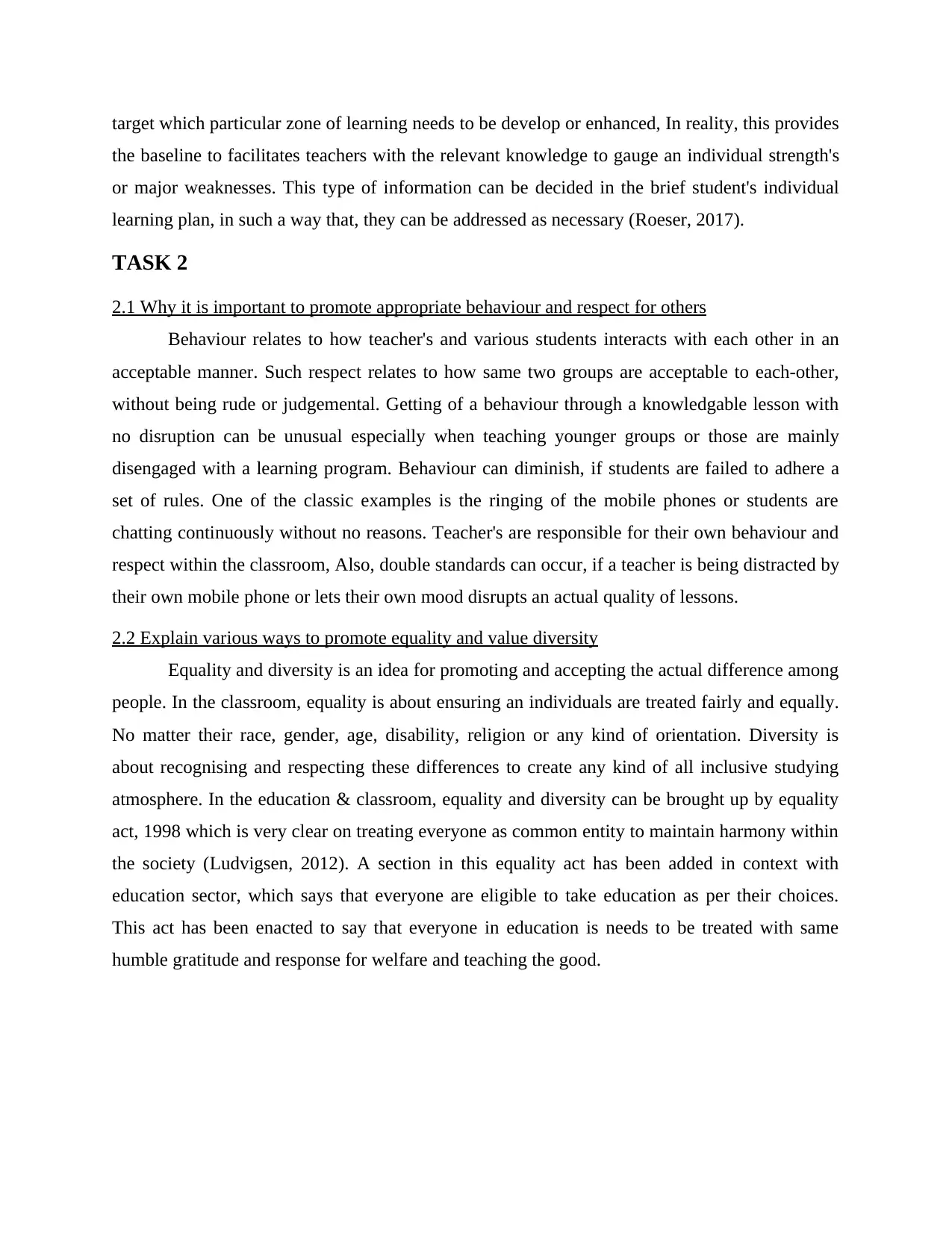
target which particular zone of learning needs to be develop or enhanced, In reality, this provides
the baseline to facilitates teachers with the relevant knowledge to gauge an individual strength's
or major weaknesses. This type of information can be decided in the brief student's individual
learning plan, in such a way that, they can be addressed as necessary (Roeser, 2017).
TASK 2
2.1 Why it is important to promote appropriate behaviour and respect for others
Behaviour relates to how teacher's and various students interacts with each other in an
acceptable manner. Such respect relates to how same two groups are acceptable to each-other,
without being rude or judgemental. Getting of a behaviour through a knowledgable lesson with
no disruption can be unusual especially when teaching younger groups or those are mainly
disengaged with a learning program. Behaviour can diminish, if students are failed to adhere a
set of rules. One of the classic examples is the ringing of the mobile phones or students are
chatting continuously without no reasons. Teacher's are responsible for their own behaviour and
respect within the classroom, Also, double standards can occur, if a teacher is being distracted by
their own mobile phone or lets their own mood disrupts an actual quality of lessons.
2.2 Explain various ways to promote equality and value diversity
Equality and diversity is an idea for promoting and accepting the actual difference among
people. In the classroom, equality is about ensuring an individuals are treated fairly and equally.
No matter their race, gender, age, disability, religion or any kind of orientation. Diversity is
about recognising and respecting these differences to create any kind of all inclusive studying
atmosphere. In the education & classroom, equality and diversity can be brought up by equality
act, 1998 which is very clear on treating everyone as common entity to maintain harmony within
the society (Ludvigsen, 2012). A section in this equality act has been added in context with
education sector, which says that everyone are eligible to take education as per their choices.
This act has been enacted to say that everyone in education is needs to be treated with same
humble gratitude and response for welfare and teaching the good.
the baseline to facilitates teachers with the relevant knowledge to gauge an individual strength's
or major weaknesses. This type of information can be decided in the brief student's individual
learning plan, in such a way that, they can be addressed as necessary (Roeser, 2017).
TASK 2
2.1 Why it is important to promote appropriate behaviour and respect for others
Behaviour relates to how teacher's and various students interacts with each other in an
acceptable manner. Such respect relates to how same two groups are acceptable to each-other,
without being rude or judgemental. Getting of a behaviour through a knowledgable lesson with
no disruption can be unusual especially when teaching younger groups or those are mainly
disengaged with a learning program. Behaviour can diminish, if students are failed to adhere a
set of rules. One of the classic examples is the ringing of the mobile phones or students are
chatting continuously without no reasons. Teacher's are responsible for their own behaviour and
respect within the classroom, Also, double standards can occur, if a teacher is being distracted by
their own mobile phone or lets their own mood disrupts an actual quality of lessons.
2.2 Explain various ways to promote equality and value diversity
Equality and diversity is an idea for promoting and accepting the actual difference among
people. In the classroom, equality is about ensuring an individuals are treated fairly and equally.
No matter their race, gender, age, disability, religion or any kind of orientation. Diversity is
about recognising and respecting these differences to create any kind of all inclusive studying
atmosphere. In the education & classroom, equality and diversity can be brought up by equality
act, 1998 which is very clear on treating everyone as common entity to maintain harmony within
the society (Ludvigsen, 2012). A section in this equality act has been added in context with
education sector, which says that everyone are eligible to take education as per their choices.
This act has been enacted to say that everyone in education is needs to be treated with same
humble gratitude and response for welfare and teaching the good.
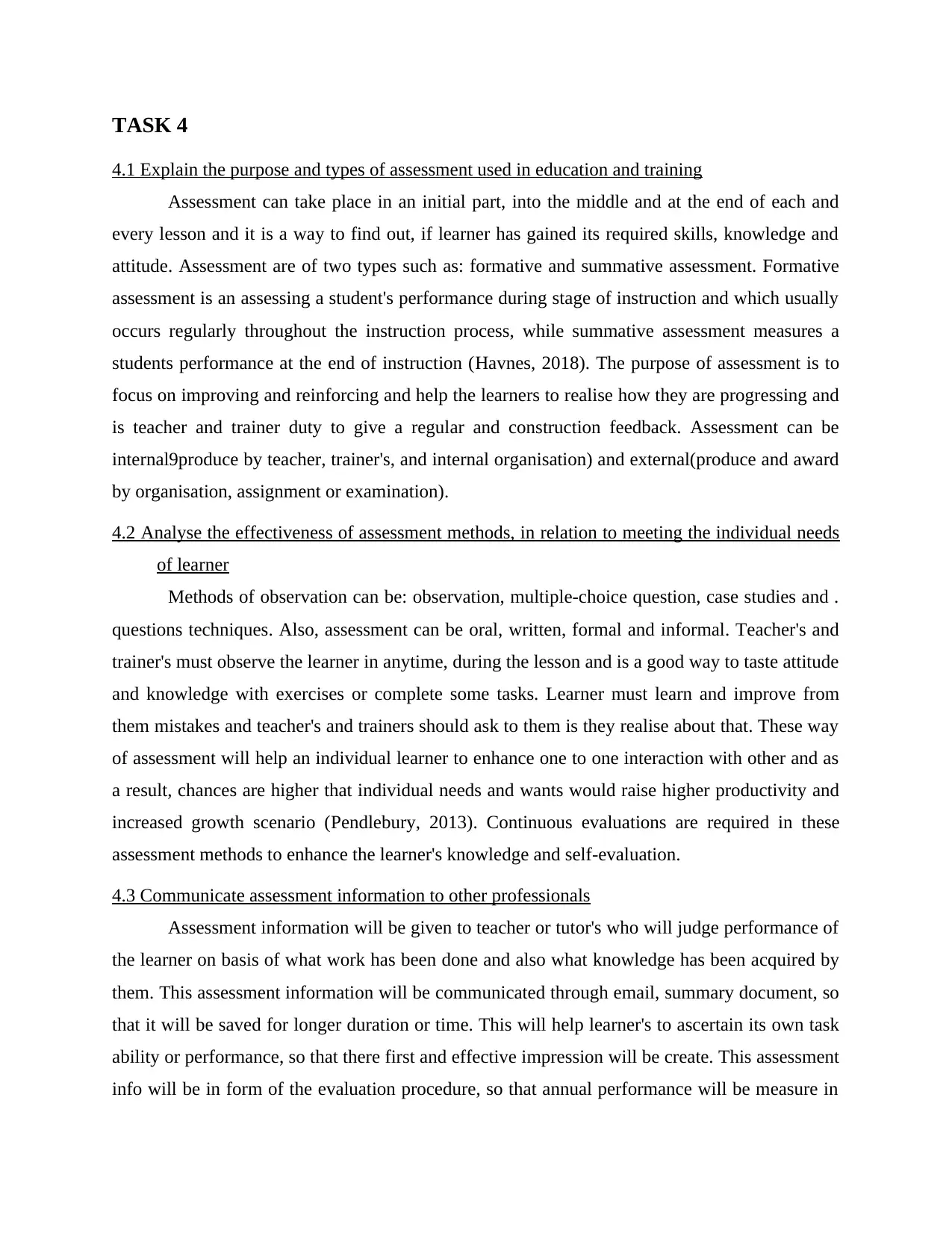
TASK 4
4.1 Explain the purpose and types of assessment used in education and training
Assessment can take place in an initial part, into the middle and at the end of each and
every lesson and it is a way to find out, if learner has gained its required skills, knowledge and
attitude. Assessment are of two types such as: formative and summative assessment. Formative
assessment is an assessing a student's performance during stage of instruction and which usually
occurs regularly throughout the instruction process, while summative assessment measures a
students performance at the end of instruction (Havnes, 2018). The purpose of assessment is to
focus on improving and reinforcing and help the learners to realise how they are progressing and
is teacher and trainer duty to give a regular and construction feedback. Assessment can be
internal9produce by teacher, trainer's, and internal organisation) and external(produce and award
by organisation, assignment or examination).
4.2 Analyse the effectiveness of assessment methods, in relation to meeting the individual needs
of learner
Methods of observation can be: observation, multiple-choice question, case studies and .
questions techniques. Also, assessment can be oral, written, formal and informal. Teacher's and
trainer's must observe the learner in anytime, during the lesson and is a good way to taste attitude
and knowledge with exercises or complete some tasks. Learner must learn and improve from
them mistakes and teacher's and trainers should ask to them is they realise about that. These way
of assessment will help an individual learner to enhance one to one interaction with other and as
a result, chances are higher that individual needs and wants would raise higher productivity and
increased growth scenario (Pendlebury, 2013). Continuous evaluations are required in these
assessment methods to enhance the learner's knowledge and self-evaluation.
4.3 Communicate assessment information to other professionals
Assessment information will be given to teacher or tutor's who will judge performance of
the learner on basis of what work has been done and also what knowledge has been acquired by
them. This assessment information will be communicated through email, summary document, so
that it will be saved for longer duration or time. This will help learner's to ascertain its own task
ability or performance, so that there first and effective impression will be create. This assessment
info will be in form of the evaluation procedure, so that annual performance will be measure in
4.1 Explain the purpose and types of assessment used in education and training
Assessment can take place in an initial part, into the middle and at the end of each and
every lesson and it is a way to find out, if learner has gained its required skills, knowledge and
attitude. Assessment are of two types such as: formative and summative assessment. Formative
assessment is an assessing a student's performance during stage of instruction and which usually
occurs regularly throughout the instruction process, while summative assessment measures a
students performance at the end of instruction (Havnes, 2018). The purpose of assessment is to
focus on improving and reinforcing and help the learners to realise how they are progressing and
is teacher and trainer duty to give a regular and construction feedback. Assessment can be
internal9produce by teacher, trainer's, and internal organisation) and external(produce and award
by organisation, assignment or examination).
4.2 Analyse the effectiveness of assessment methods, in relation to meeting the individual needs
of learner
Methods of observation can be: observation, multiple-choice question, case studies and .
questions techniques. Also, assessment can be oral, written, formal and informal. Teacher's and
trainer's must observe the learner in anytime, during the lesson and is a good way to taste attitude
and knowledge with exercises or complete some tasks. Learner must learn and improve from
them mistakes and teacher's and trainers should ask to them is they realise about that. These way
of assessment will help an individual learner to enhance one to one interaction with other and as
a result, chances are higher that individual needs and wants would raise higher productivity and
increased growth scenario (Pendlebury, 2013). Continuous evaluations are required in these
assessment methods to enhance the learner's knowledge and self-evaluation.
4.3 Communicate assessment information to other professionals
Assessment information will be given to teacher or tutor's who will judge performance of
the learner on basis of what work has been done and also what knowledge has been acquired by
them. This assessment information will be communicated through email, summary document, so
that it will be saved for longer duration or time. This will help learner's to ascertain its own task
ability or performance, so that there first and effective impression will be create. This assessment
info will be in form of the evaluation procedure, so that annual performance will be measure in
⊘ This is a preview!⊘
Do you want full access?
Subscribe today to unlock all pages.

Trusted by 1+ million students worldwide
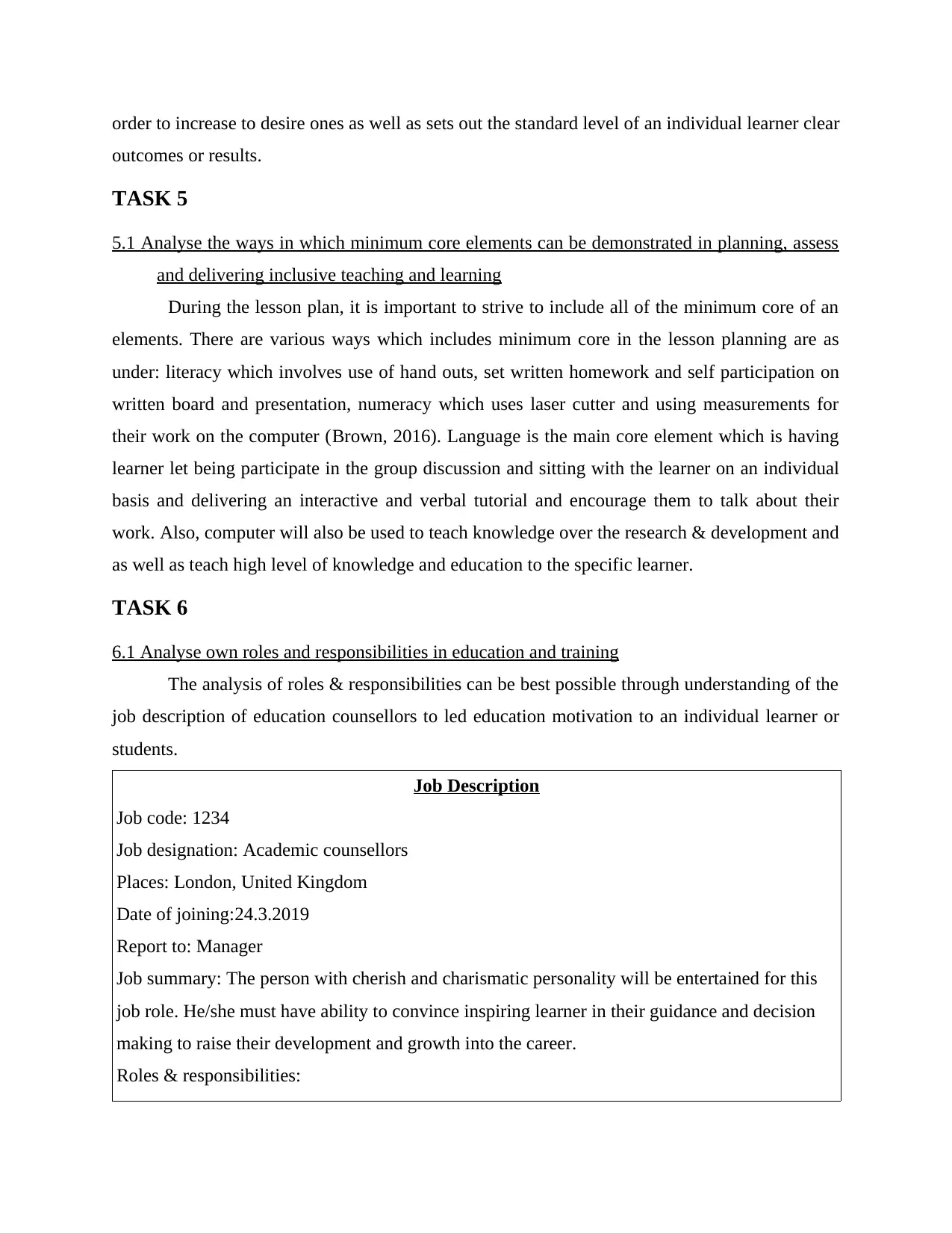
order to increase to desire ones as well as sets out the standard level of an individual learner clear
outcomes or results.
TASK 5
5.1 Analyse the ways in which minimum core elements can be demonstrated in planning, assess
and delivering inclusive teaching and learning
During the lesson plan, it is important to strive to include all of the minimum core of an
elements. There are various ways which includes minimum core in the lesson planning are as
under: literacy which involves use of hand outs, set written homework and self participation on
written board and presentation, numeracy which uses laser cutter and using measurements for
their work on the computer (Brown, 2016). Language is the main core element which is having
learner let being participate in the group discussion and sitting with the learner on an individual
basis and delivering an interactive and verbal tutorial and encourage them to talk about their
work. Also, computer will also be used to teach knowledge over the research & development and
as well as teach high level of knowledge and education to the specific learner.
TASK 6
6.1 Analyse own roles and responsibilities in education and training
The analysis of roles & responsibilities can be best possible through understanding of the
job description of education counsellors to led education motivation to an individual learner or
students.
Job Description
Job code: 1234
Job designation: Academic counsellors
Places: London, United Kingdom
Date of joining:24.3.2019
Report to: Manager
Job summary: The person with cherish and charismatic personality will be entertained for this
job role. He/she must have ability to convince inspiring learner in their guidance and decision
making to raise their development and growth into the career.
Roles & responsibilities:
outcomes or results.
TASK 5
5.1 Analyse the ways in which minimum core elements can be demonstrated in planning, assess
and delivering inclusive teaching and learning
During the lesson plan, it is important to strive to include all of the minimum core of an
elements. There are various ways which includes minimum core in the lesson planning are as
under: literacy which involves use of hand outs, set written homework and self participation on
written board and presentation, numeracy which uses laser cutter and using measurements for
their work on the computer (Brown, 2016). Language is the main core element which is having
learner let being participate in the group discussion and sitting with the learner on an individual
basis and delivering an interactive and verbal tutorial and encourage them to talk about their
work. Also, computer will also be used to teach knowledge over the research & development and
as well as teach high level of knowledge and education to the specific learner.
TASK 6
6.1 Analyse own roles and responsibilities in education and training
The analysis of roles & responsibilities can be best possible through understanding of the
job description of education counsellors to led education motivation to an individual learner or
students.
Job Description
Job code: 1234
Job designation: Academic counsellors
Places: London, United Kingdom
Date of joining:24.3.2019
Report to: Manager
Job summary: The person with cherish and charismatic personality will be entertained for this
job role. He/she must have ability to convince inspiring learner in their guidance and decision
making to raise their development and growth into the career.
Roles & responsibilities:
Paraphrase This Document
Need a fresh take? Get an instant paraphrase of this document with our AI Paraphraser
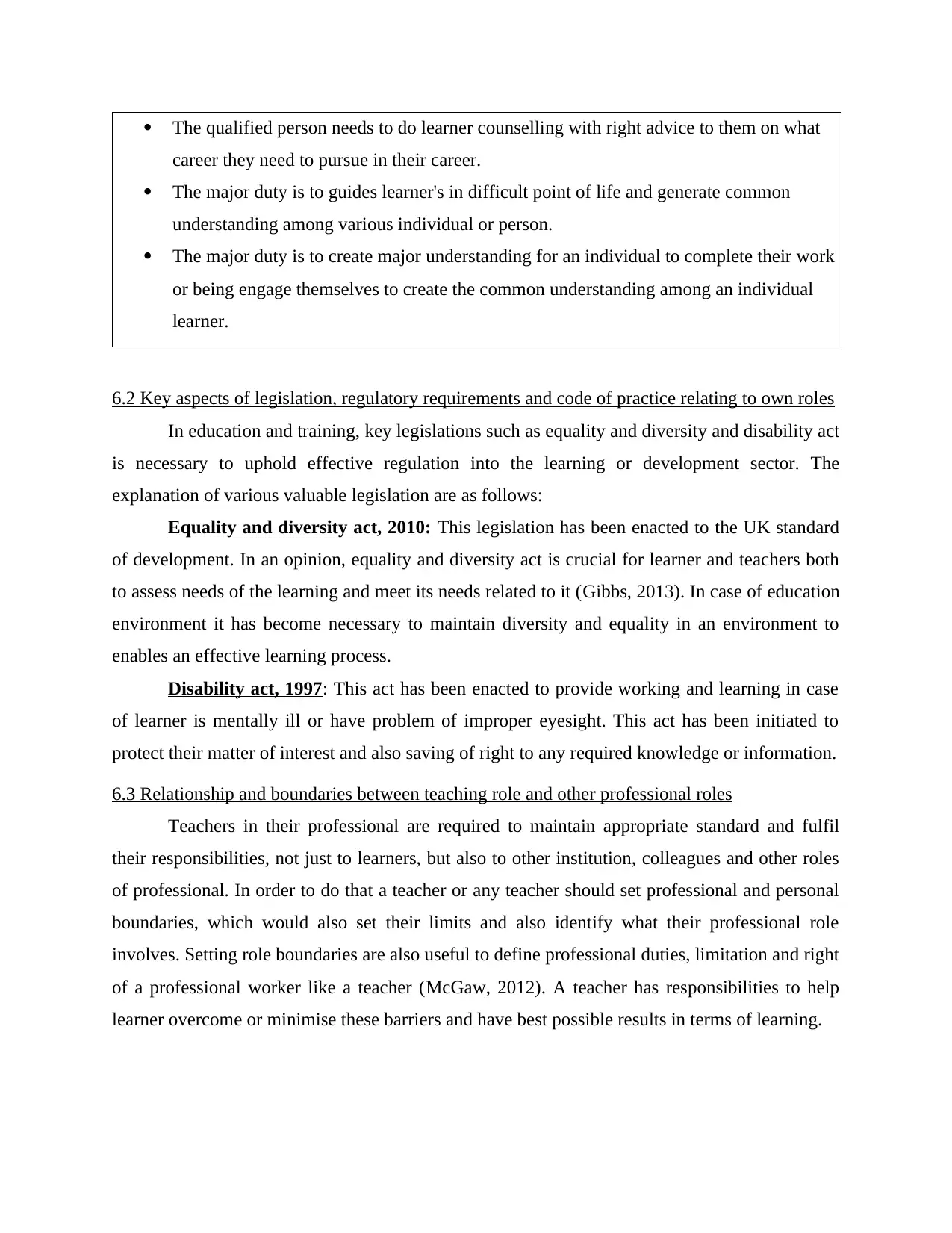
The qualified person needs to do learner counselling with right advice to them on what
career they need to pursue in their career.
The major duty is to guides learner's in difficult point of life and generate common
understanding among various individual or person.
The major duty is to create major understanding for an individual to complete their work
or being engage themselves to create the common understanding among an individual
learner.
6.2 Key aspects of legislation, regulatory requirements and code of practice relating to own roles
In education and training, key legislations such as equality and diversity and disability act
is necessary to uphold effective regulation into the learning or development sector. The
explanation of various valuable legislation are as follows:
Equality and diversity act, 2010: This legislation has been enacted to the UK standard
of development. In an opinion, equality and diversity act is crucial for learner and teachers both
to assess needs of the learning and meet its needs related to it (Gibbs, 2013). In case of education
environment it has become necessary to maintain diversity and equality in an environment to
enables an effective learning process.
Disability act, 1997: This act has been enacted to provide working and learning in case
of learner is mentally ill or have problem of improper eyesight. This act has been initiated to
protect their matter of interest and also saving of right to any required knowledge or information.
6.3 Relationship and boundaries between teaching role and other professional roles
Teachers in their professional are required to maintain appropriate standard and fulfil
their responsibilities, not just to learners, but also to other institution, colleagues and other roles
of professional. In order to do that a teacher or any teacher should set professional and personal
boundaries, which would also set their limits and also identify what their professional role
involves. Setting role boundaries are also useful to define professional duties, limitation and right
of a professional worker like a teacher (McGaw, 2012). A teacher has responsibilities to help
learner overcome or minimise these barriers and have best possible results in terms of learning.
career they need to pursue in their career.
The major duty is to guides learner's in difficult point of life and generate common
understanding among various individual or person.
The major duty is to create major understanding for an individual to complete their work
or being engage themselves to create the common understanding among an individual
learner.
6.2 Key aspects of legislation, regulatory requirements and code of practice relating to own roles
In education and training, key legislations such as equality and diversity and disability act
is necessary to uphold effective regulation into the learning or development sector. The
explanation of various valuable legislation are as follows:
Equality and diversity act, 2010: This legislation has been enacted to the UK standard
of development. In an opinion, equality and diversity act is crucial for learner and teachers both
to assess needs of the learning and meet its needs related to it (Gibbs, 2013). In case of education
environment it has become necessary to maintain diversity and equality in an environment to
enables an effective learning process.
Disability act, 1997: This act has been enacted to provide working and learning in case
of learner is mentally ill or have problem of improper eyesight. This act has been initiated to
protect their matter of interest and also saving of right to any required knowledge or information.
6.3 Relationship and boundaries between teaching role and other professional roles
Teachers in their professional are required to maintain appropriate standard and fulfil
their responsibilities, not just to learners, but also to other institution, colleagues and other roles
of professional. In order to do that a teacher or any teacher should set professional and personal
boundaries, which would also set their limits and also identify what their professional role
involves. Setting role boundaries are also useful to define professional duties, limitation and right
of a professional worker like a teacher (McGaw, 2012). A teacher has responsibilities to help
learner overcome or minimise these barriers and have best possible results in terms of learning.
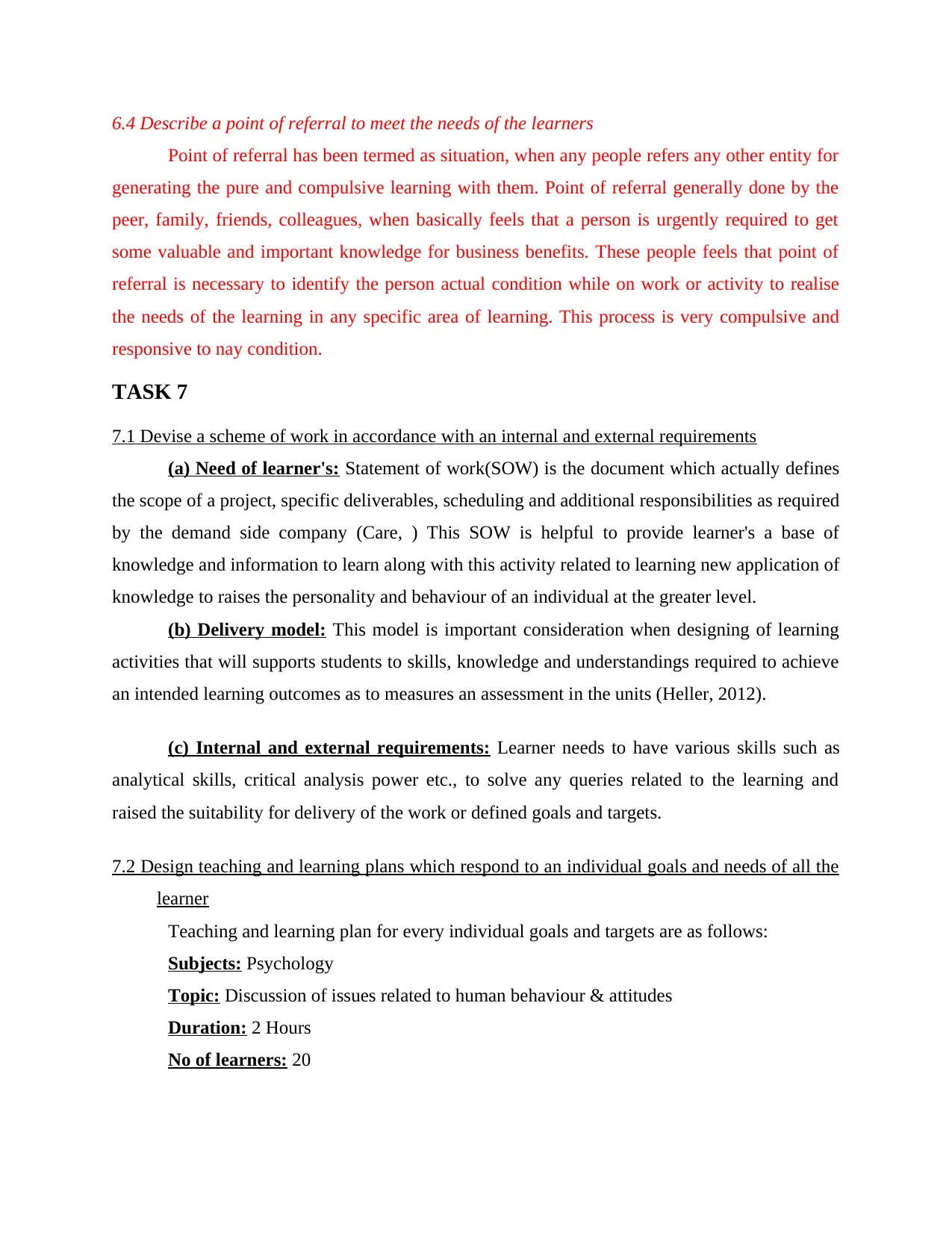
6.4 Describe a point of referral to meet the needs of the learners
Point of referral has been termed as situation, when any people refers any other entity for
generating the pure and compulsive learning with them. Point of referral generally done by the
peer, family, friends, colleagues, when basically feels that a person is urgently required to get
some valuable and important knowledge for business benefits. These people feels that point of
referral is necessary to identify the person actual condition while on work or activity to realise
the needs of the learning in any specific area of learning. This process is very compulsive and
responsive to nay condition.
TASK 7
7.1 Devise a scheme of work in accordance with an internal and external requirements
(a) Need of learner's: Statement of work(SOW) is the document which actually defines
the scope of a project, specific deliverables, scheduling and additional responsibilities as required
by the demand side company (Care, ) This SOW is helpful to provide learner's a base of
knowledge and information to learn along with this activity related to learning new application of
knowledge to raises the personality and behaviour of an individual at the greater level.
(b) Delivery model: This model is important consideration when designing of learning
activities that will supports students to skills, knowledge and understandings required to achieve
an intended learning outcomes as to measures an assessment in the units (Heller, 2012).
(c) Internal and external requirements: Learner needs to have various skills such as
analytical skills, critical analysis power etc., to solve any queries related to the learning and
raised the suitability for delivery of the work or defined goals and targets.
7.2 Design teaching and learning plans which respond to an individual goals and needs of all the
learner
Teaching and learning plan for every individual goals and targets are as follows:
Subjects: Psychology
Topic: Discussion of issues related to human behaviour & attitudes
Duration: 2 Hours
No of learners: 20
Point of referral has been termed as situation, when any people refers any other entity for
generating the pure and compulsive learning with them. Point of referral generally done by the
peer, family, friends, colleagues, when basically feels that a person is urgently required to get
some valuable and important knowledge for business benefits. These people feels that point of
referral is necessary to identify the person actual condition while on work or activity to realise
the needs of the learning in any specific area of learning. This process is very compulsive and
responsive to nay condition.
TASK 7
7.1 Devise a scheme of work in accordance with an internal and external requirements
(a) Need of learner's: Statement of work(SOW) is the document which actually defines
the scope of a project, specific deliverables, scheduling and additional responsibilities as required
by the demand side company (Care, ) This SOW is helpful to provide learner's a base of
knowledge and information to learn along with this activity related to learning new application of
knowledge to raises the personality and behaviour of an individual at the greater level.
(b) Delivery model: This model is important consideration when designing of learning
activities that will supports students to skills, knowledge and understandings required to achieve
an intended learning outcomes as to measures an assessment in the units (Heller, 2012).
(c) Internal and external requirements: Learner needs to have various skills such as
analytical skills, critical analysis power etc., to solve any queries related to the learning and
raised the suitability for delivery of the work or defined goals and targets.
7.2 Design teaching and learning plans which respond to an individual goals and needs of all the
learner
Teaching and learning plan for every individual goals and targets are as follows:
Subjects: Psychology
Topic: Discussion of issues related to human behaviour & attitudes
Duration: 2 Hours
No of learners: 20
⊘ This is a preview!⊘
Do you want full access?
Subscribe today to unlock all pages.

Trusted by 1+ million students worldwide
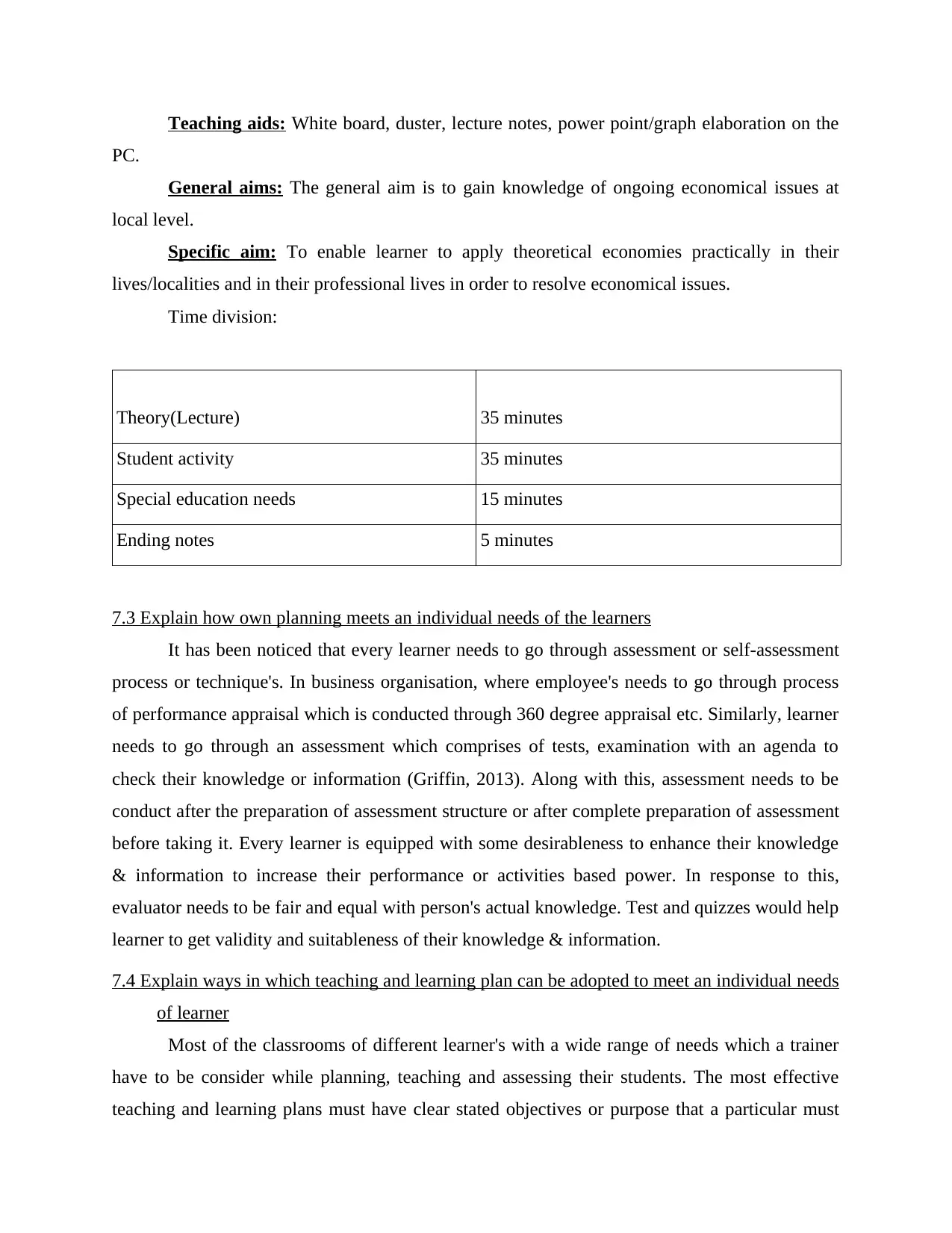
Teaching aids: White board, duster, lecture notes, power point/graph elaboration on the
PC.
General aims: The general aim is to gain knowledge of ongoing economical issues at
local level.
Specific aim: To enable learner to apply theoretical economies practically in their
lives/localities and in their professional lives in order to resolve economical issues.
Time division:
Theory(Lecture) 35 minutes
Student activity 35 minutes
Special education needs 15 minutes
Ending notes 5 minutes
7.3 Explain how own planning meets an individual needs of the learners
It has been noticed that every learner needs to go through assessment or self-assessment
process or technique's. In business organisation, where employee's needs to go through process
of performance appraisal which is conducted through 360 degree appraisal etc. Similarly, learner
needs to go through an assessment which comprises of tests, examination with an agenda to
check their knowledge or information (Griffin, 2013). Along with this, assessment needs to be
conduct after the preparation of assessment structure or after complete preparation of assessment
before taking it. Every learner is equipped with some desirableness to enhance their knowledge
& information to increase their performance or activities based power. In response to this,
evaluator needs to be fair and equal with person's actual knowledge. Test and quizzes would help
learner to get validity and suitableness of their knowledge & information.
7.4 Explain ways in which teaching and learning plan can be adopted to meet an individual needs
of learner
Most of the classrooms of different learner's with a wide range of needs which a trainer
have to be consider while planning, teaching and assessing their students. The most effective
teaching and learning plans must have clear stated objectives or purpose that a particular must
PC.
General aims: The general aim is to gain knowledge of ongoing economical issues at
local level.
Specific aim: To enable learner to apply theoretical economies practically in their
lives/localities and in their professional lives in order to resolve economical issues.
Time division:
Theory(Lecture) 35 minutes
Student activity 35 minutes
Special education needs 15 minutes
Ending notes 5 minutes
7.3 Explain how own planning meets an individual needs of the learners
It has been noticed that every learner needs to go through assessment or self-assessment
process or technique's. In business organisation, where employee's needs to go through process
of performance appraisal which is conducted through 360 degree appraisal etc. Similarly, learner
needs to go through an assessment which comprises of tests, examination with an agenda to
check their knowledge or information (Griffin, 2013). Along with this, assessment needs to be
conduct after the preparation of assessment structure or after complete preparation of assessment
before taking it. Every learner is equipped with some desirableness to enhance their knowledge
& information to increase their performance or activities based power. In response to this,
evaluator needs to be fair and equal with person's actual knowledge. Test and quizzes would help
learner to get validity and suitableness of their knowledge & information.
7.4 Explain ways in which teaching and learning plan can be adopted to meet an individual needs
of learner
Most of the classrooms of different learner's with a wide range of needs which a trainer
have to be consider while planning, teaching and assessing their students. The most effective
teaching and learning plans must have clear stated objectives or purpose that a particular must
Paraphrase This Document
Need a fresh take? Get an instant paraphrase of this document with our AI Paraphraser
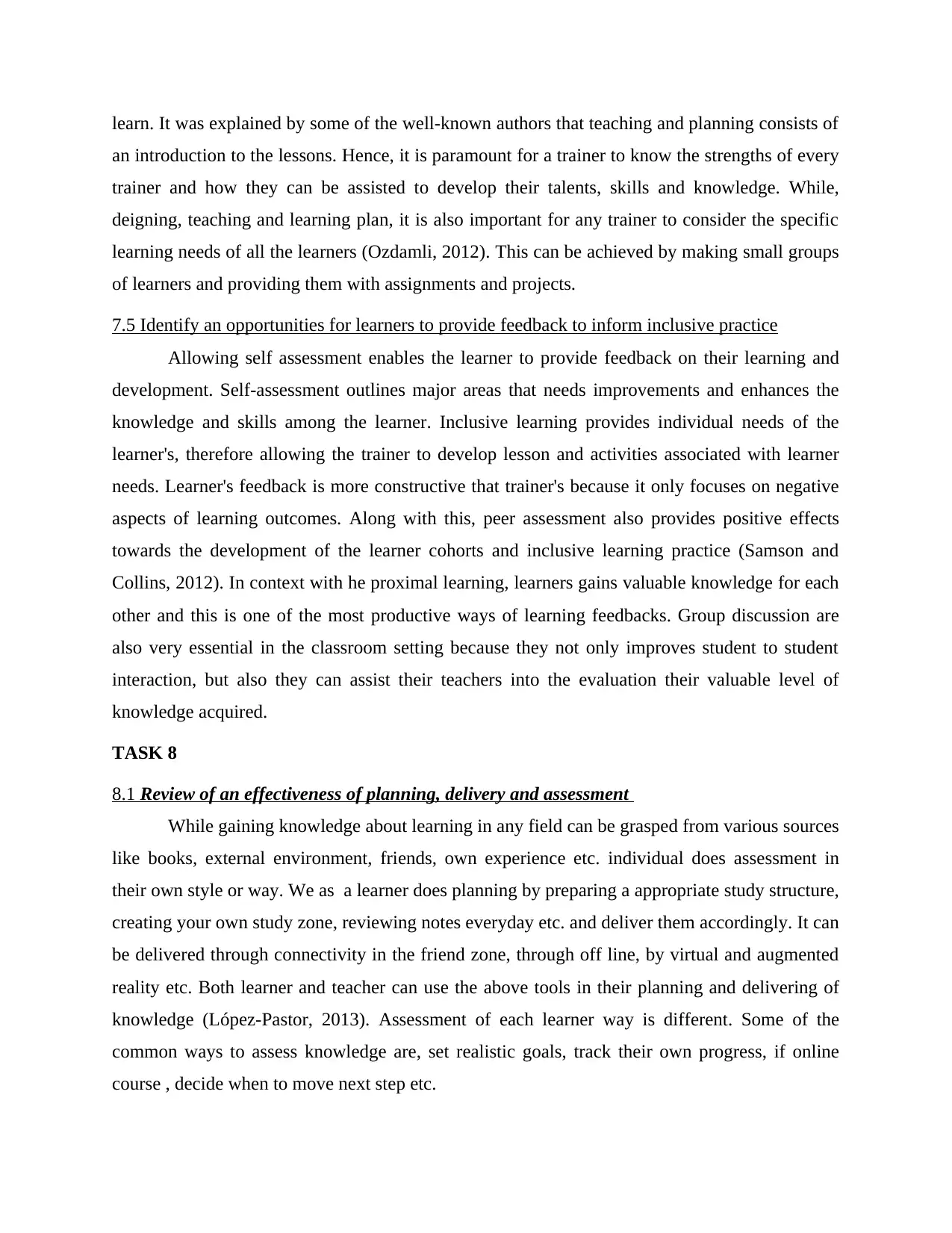
learn. It was explained by some of the well-known authors that teaching and planning consists of
an introduction to the lessons. Hence, it is paramount for a trainer to know the strengths of every
trainer and how they can be assisted to develop their talents, skills and knowledge. While,
deigning, teaching and learning plan, it is also important for any trainer to consider the specific
learning needs of all the learners (Ozdamli, 2012). This can be achieved by making small groups
of learners and providing them with assignments and projects.
7.5 Identify an opportunities for learners to provide feedback to inform inclusive practice
Allowing self assessment enables the learner to provide feedback on their learning and
development. Self-assessment outlines major areas that needs improvements and enhances the
knowledge and skills among the learner. Inclusive learning provides individual needs of the
learner's, therefore allowing the trainer to develop lesson and activities associated with learner
needs. Learner's feedback is more constructive that trainer's because it only focuses on negative
aspects of learning outcomes. Along with this, peer assessment also provides positive effects
towards the development of the learner cohorts and inclusive learning practice (Samson and
Collins, 2012). In context with he proximal learning, learners gains valuable knowledge for each
other and this is one of the most productive ways of learning feedbacks. Group discussion are
also very essential in the classroom setting because they not only improves student to student
interaction, but also they can assist their teachers into the evaluation their valuable level of
knowledge acquired.
TASK 8
8.1 Review of an effectiveness of planning, delivery and assessment
While gaining knowledge about learning in any field can be grasped from various sources
like books, external environment, friends, own experience etc. individual does assessment in
their own style or way. We as a learner does planning by preparing a appropriate study structure,
creating your own study zone, reviewing notes everyday etc. and deliver them accordingly. It can
be delivered through connectivity in the friend zone, through off line, by virtual and augmented
reality etc. Both learner and teacher can use the above tools in their planning and delivering of
knowledge (López-Pastor, 2013). Assessment of each learner way is different. Some of the
common ways to assess knowledge are, set realistic goals, track their own progress, if online
course , decide when to move next step etc.
an introduction to the lessons. Hence, it is paramount for a trainer to know the strengths of every
trainer and how they can be assisted to develop their talents, skills and knowledge. While,
deigning, teaching and learning plan, it is also important for any trainer to consider the specific
learning needs of all the learners (Ozdamli, 2012). This can be achieved by making small groups
of learners and providing them with assignments and projects.
7.5 Identify an opportunities for learners to provide feedback to inform inclusive practice
Allowing self assessment enables the learner to provide feedback on their learning and
development. Self-assessment outlines major areas that needs improvements and enhances the
knowledge and skills among the learner. Inclusive learning provides individual needs of the
learner's, therefore allowing the trainer to develop lesson and activities associated with learner
needs. Learner's feedback is more constructive that trainer's because it only focuses on negative
aspects of learning outcomes. Along with this, peer assessment also provides positive effects
towards the development of the learner cohorts and inclusive learning practice (Samson and
Collins, 2012). In context with he proximal learning, learners gains valuable knowledge for each
other and this is one of the most productive ways of learning feedbacks. Group discussion are
also very essential in the classroom setting because they not only improves student to student
interaction, but also they can assist their teachers into the evaluation their valuable level of
knowledge acquired.
TASK 8
8.1 Review of an effectiveness of planning, delivery and assessment
While gaining knowledge about learning in any field can be grasped from various sources
like books, external environment, friends, own experience etc. individual does assessment in
their own style or way. We as a learner does planning by preparing a appropriate study structure,
creating your own study zone, reviewing notes everyday etc. and deliver them accordingly. It can
be delivered through connectivity in the friend zone, through off line, by virtual and augmented
reality etc. Both learner and teacher can use the above tools in their planning and delivering of
knowledge (López-Pastor, 2013). Assessment of each learner way is different. Some of the
common ways to assess knowledge are, set realistic goals, track their own progress, if online
course , decide when to move next step etc.
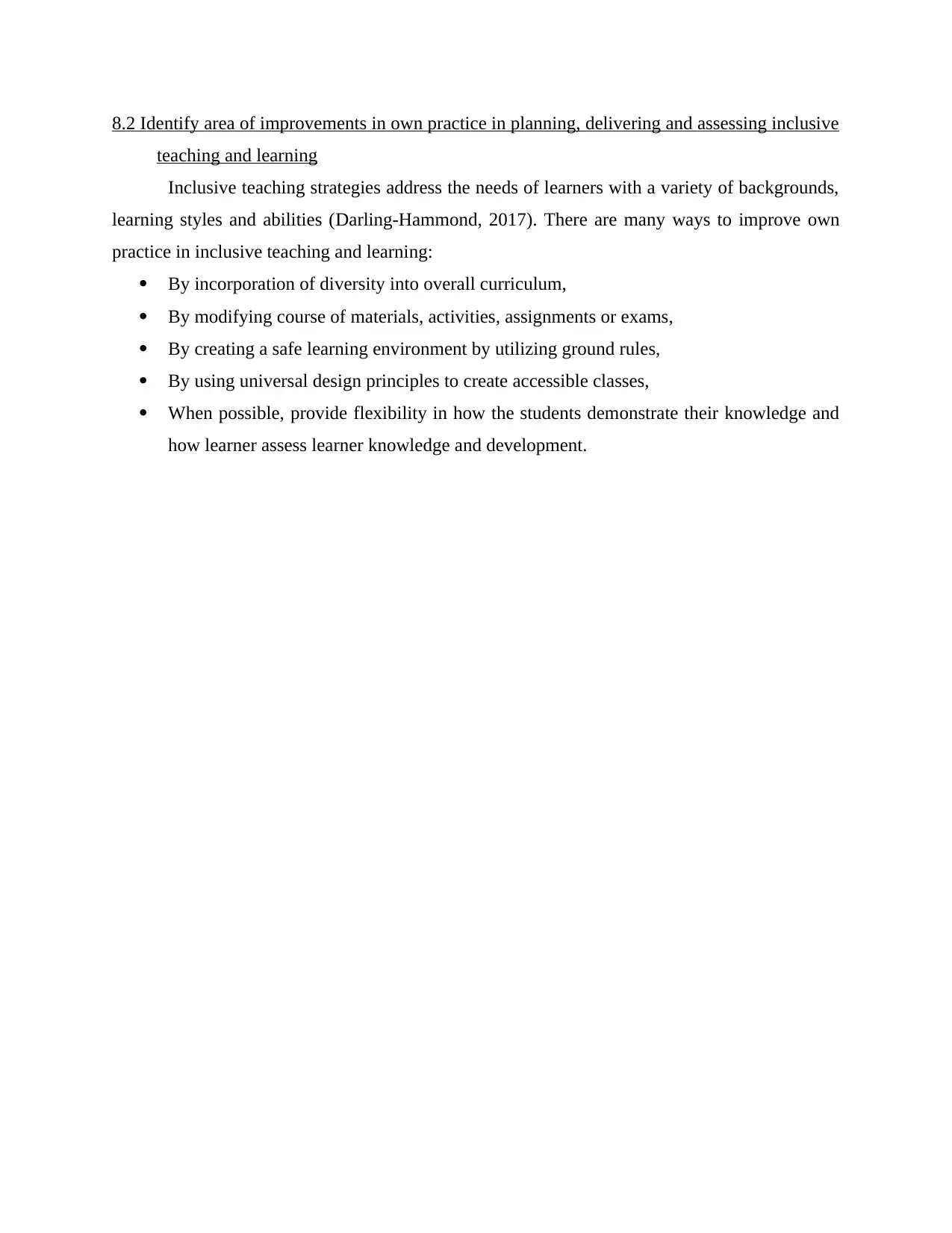
8.2 Identify area of improvements in own practice in planning, delivering and assessing inclusive
teaching and learning
Inclusive teaching strategies address the needs of learners with a variety of backgrounds,
learning styles and abilities (Darling-Hammond, 2017). There are many ways to improve own
practice in inclusive teaching and learning:
By incorporation of diversity into overall curriculum,
By modifying course of materials, activities, assignments or exams,
By creating a safe learning environment by utilizing ground rules,
By using universal design principles to create accessible classes,
When possible, provide flexibility in how the students demonstrate their knowledge and
how learner assess learner knowledge and development.
teaching and learning
Inclusive teaching strategies address the needs of learners with a variety of backgrounds,
learning styles and abilities (Darling-Hammond, 2017). There are many ways to improve own
practice in inclusive teaching and learning:
By incorporation of diversity into overall curriculum,
By modifying course of materials, activities, assignments or exams,
By creating a safe learning environment by utilizing ground rules,
By using universal design principles to create accessible classes,
When possible, provide flexibility in how the students demonstrate their knowledge and
how learner assess learner knowledge and development.
⊘ This is a preview!⊘
Do you want full access?
Subscribe today to unlock all pages.

Trusted by 1+ million students worldwide
1 out of 15
Related Documents
Your All-in-One AI-Powered Toolkit for Academic Success.
+13062052269
info@desklib.com
Available 24*7 on WhatsApp / Email
![[object Object]](/_next/static/media/star-bottom.7253800d.svg)
Unlock your academic potential
Copyright © 2020–2025 A2Z Services. All Rights Reserved. Developed and managed by ZUCOL.



